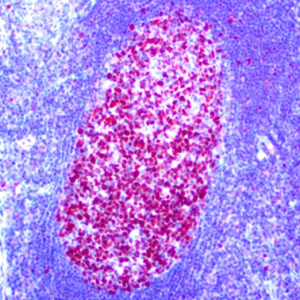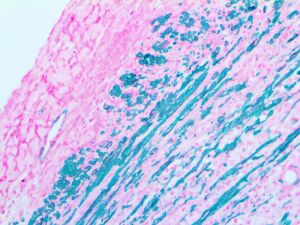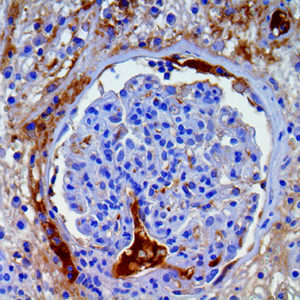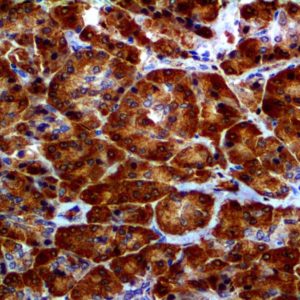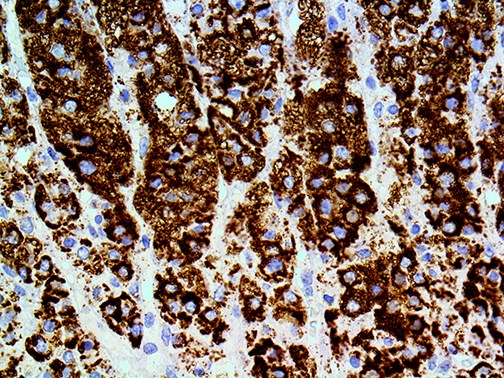
IHC of Adipophilin on an FFPE Squamous Cell Carcinoma Tissue
| Intended Use | For In Vitro Diagnostic Use | |||||||||||||||||||||||||||||||||||
| Summary and Explanation | Adipose differentiation-related protein, also known as perilipin 2 (PLIN2), ADRP or adipophilin, is a protein which in humans is encoded by the ADFP gene. Adipocyte differentiation-related protein is associated with the globule surface membrane material. This protein is a major constituent of the globule surface. Increase in mRNA levels is one of the earliest indications of adipocyte differentiation. Adipophilin occurs in a wide range of cultured cell lines, including fibroblasts and endothelial and epithelial cells. In tissues, however, expression of adipophilin is restricted to certain cell types, such as lactating mammary epithelial cells, adrenal cortex cells, Sertoli and Leydig cells of the male reproductive system, and steatosis or fatty change hepatocytes in alcoholic liver cirrhosis. Adipophilin expression in various sebaceous lesions and other cutaneous tumors with a clear cell histology that may mimic sebaceous differentiation. Adipophilin can be valuable in an immunohistochemical panel when evaluating cutaneous lesions with clear cell histology as it identifies intracytoplasmic lipid vesicles in sebaceous and xanthomatous lesions. In periocular lesions, it is effective in helping to exclude basal cell carcinoma and squamous cell carcinoma when sebaceous carcinoma is under consideration. Adipophilin expression is not as useful for the differential diagnosis that includes metastatic renal cell carcinoma, a rare but important, diagnostic differential. The pattern of adipophilin reactivity is important to observe as membranous vesicular staining is suggestive of intracellular lipids whereas granular cytoplasmic reactivity is not. Adipophilin is suitable for immunostaining and is helpful in the identification of intracytoplasmic lipids, as seen in sebaceous lesions. It is especially helpful in identifying intracytoplasmic lipid vesicles in poorly differentiated sebaceous carcinomas in challenging cases such as small periocular biopsy specimens. | |||||||||||||||||||||||||||||||||||
| Antibody Type | Mouse Monoclonal | Clone | BSB-91 | |||||||||||||||||||||||||||||||||
| Isotype | IgG1 | Reactivity | Paraffin, Frozen | |||||||||||||||||||||||||||||||||
| Localization | Cytoplasmic, Membranous | Control | Adrenal, SCC, TCC Sebaceous Neoplasms | |||||||||||||||||||||||||||||||||
| Presentation | Adipophilin is a rabbit monoclonal antibody derived from cell culture supernatant that is concentrated, dialyzed, filter sterilized and diluted in buffer pH 7.5, containing BSA and sodium azide as a preservative. | |||||||||||||||||||||||||||||||||||
| Availability |
| |||||||||||||||||||||||||||||||||||
| Note: For concentrated antibodies, please centrifuge prior to use to ensure recovery of all product. | ||||||||||||||||||||||||||||||||||||
